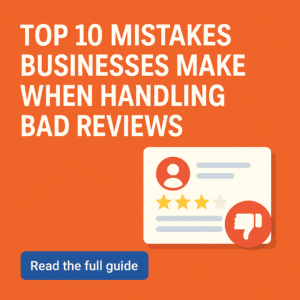Top 10 Mistakes Businesses Make When Handling Bad Reviews
In 2025, online reviews can make or break a business. A single negative review can turn away dozens of potential customers or job candidates before you even get a chance to interact with them. But the damage isn’t always in the review itself — it’s often in how a business responds (or doesn’t respond) to it.
Here are the ten most common mistakes businesses make when dealing with bad reviews — and how to avoid them.
Mistake 1: Ignoring Bad Reviews Altogether
Silence speaks volumes. When businesses ignore negative feedback, potential customers interpret it as a lack of care or accountability. Ignoring reviews also means missing out on a valuable chance to address issues publicly and show that you take feedback seriously. Even if you can’t fully resolve a situation, acknowledging it demonstrates professionalism and empathy.
Mistake 2: Responding Emotionally or Defensively
Receiving a harsh review can feel personal, but emotional or defensive responses only escalate the problem. Angry replies make your brand look unprofessional and can deter future customers. Instead, keep responses calm, respectful, and solution-focused. Thank the reviewer for their feedback, acknowledge their concerns, and offer to discuss the issue offline when appropriate.
Mistake 3: Copy-Pasting Generic Responses
Many businesses resort to using the same generic response for every negative review. While this might save time, it comes off as insincere and robotic. Personalized responses show that you’re genuinely listening and care about each customer’s experience. Mention specific details from the review and tailor your message accordingly.
Mistake 4: Delaying Responses for Too Long
Speed matters. Waiting too long to reply to negative feedback makes it seem like you don’t prioritize customer satisfaction. Worse, it allows the negative narrative to sit unchallenged. Aim to respond within 24–48 hours whenever possible. Quick responses help contain the issue and can even turn unhappy customers into loyal advocates.
Mistake 5: Over-Apologizing Without Taking Action
While it’s important to apologize when something goes wrong, simply saying “sorry” isn’t enough. Customers want to know what you’re doing to prevent similar issues in the future. Over-apologizing without follow-through can appear weak and hollow. Instead, acknowledge the problem, outline the steps you’re taking to fix it, and offer further support if needed.
Mistake 6: Offering Incentives to Remove Reviews
Attempting to bribe customers to delete or change a review is a big mistake — and it can violate platform policies, leading to penalties or even account suspension. Instead of trying to buy your way out of negative feedback, focus on resolving the issue authentically. A satisfied customer may choose to update their review voluntarily after a genuine resolution.
Mistake 7: Not Investigating the Root Cause Internally
A bad review is often a symptom of a deeper problem. Whether it’s a recurring service failure, poor communication, or product quality issues, businesses should treat every negative review as an opportunity to improve. Ignoring these insights can lead to repeated complaints and long-term reputation damage.
Mistake 8: Not Encouraging More Positive Reviews
Relying only on organic feedback without actively encouraging happy customers to share their experiences is a missed opportunity. Fresh positive reviews can help balance the occasional negative one and improve your overall rating. Make it easy for satisfied customers to leave reviews through post-purchase emails, follow-ups, or in-person requests.
Mistake 9: Forgetting to Monitor Employee Review Sites
Many businesses focus on customer-facing platforms like Google and Yelp but overlook employee review sites such as Glassdoor and Indeed. Negative employee reviews can significantly affect your ability to attract top talent. Regularly monitoring these platforms and addressing issues transparently can strengthen your employer brand and hiring outcomes.
Mistake 10: Not Having a Clear Review Management Strategy
Dealing with reviews reactively instead of proactively can leave your brand vulnerable. Without a structured approach, teams may scramble to respond or make inconsistent decisions that further harm your reputation. Establish a clear review management strategy that includes monitoring, responding guidelines, escalation procedures, and when to consider removal or professional help.
Conclusion
Bad reviews happen to even the best businesses. But how you handle them defines your brand far more than the reviews themselves. Avoiding these common mistakes can turn challenging feedback into an opportunity to demonstrate transparency, accountability, and excellent customer service.
If your business is struggling with negative reviews or needs help creating a proactive reputation strategy, Review Rescue is here to help. From review removal to full-scale reputation management, we partner with businesses to protect and enhance their online image.



